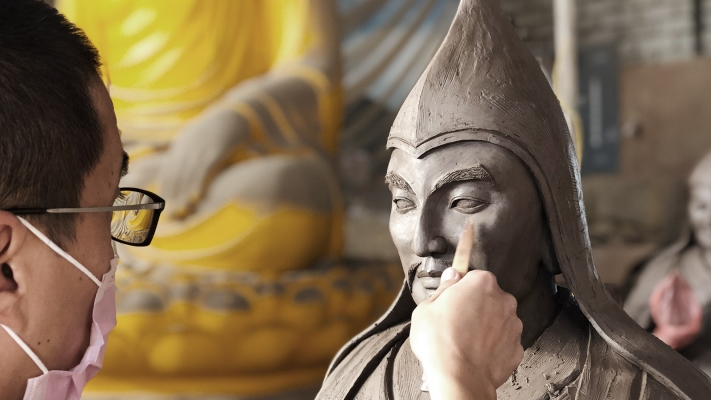In 2017, we began a special project to create statues of His Eminence Tsem Rinpoche’s previous lives, as revealed by Dorje Shugden in 2015. This project is nearing completion with all statues safely arrived in Kechara Forest Retreat.
We’re now in the process of cleaning and inserting the statues with holy items. Once completed, they will be installed in the Tsem Rinpoche Relic Temple so that everyone can pay homage and receive the blessings of Rinpoche’s special line of incarnations.
The Significance of a Tulku
In the Buddhist scriptures, tulku simply refers to the emanation body of an enlightened being. However in the Tibetan context, tulkus refer to great masters who have taken rebirth in order to continue their previous lives’ work to benefit sentient beings.
Some tulkus are direct emanations of enlightened beings such as Chenrezig, Manjushri or Heruka. Others come from a long line of reincarnations that go all the way back to ancient India.
Regardless of the length of their incarnation line, young tulkus naturally possess tremendous positive potential to benefit others, and a deep affinity with the Buddha’s teachings. Therefore, they are able to pick up Buddhist rituals and master complex philosophies with much ease. They also have great compassion for all beings especially animals.
Official Recognition as a Tulku
The recognition of a tulku typically comes from esteemed lineage lamas, great monasteries and oracles who take trance of enlightened protector deities. During his lifetime, His Eminence Tsem Rinpoche was verbally recognised as a tulku on a number of occasions, and formally recognised three times.
The first formal recognition came from His Eminence Drigung Kyabgön Rinpoche, a clairvoyant master of the Kagyu School and a highly regarded divination master. Upon sight, Drigung Rinpoche recognised Tsem Rinpoche as a tulku and issued a formal proclamation on his official stationery.
In this recognition paper, Drigung Rinpoche described Tsem Rinpoche as a mahasattva. A mahasattva is a high level bodhisattva — a master whose actions in every lifetime are of the highest benefit to the preservation and growth of the Buddha’s teachings and to sentient beings. This mahasattva recognition was also a hint of a much longer line of incarnations that would later be revealed.
The second formal recognition came by way of Gaden Shartse Monastery’s official oracle who takes trance of Setrap and Dorje Shugden. This recognition was requested by His Eminence Kensur Jampa Yeshe Rinpoche at the behest of His Eminence. Drubwang Gangchen Rinpoche.
The Gaden Oracle’s recognition revealed the identity of Tsem Rinpoche’s two preceding incarnations, Kentrul Thubten Lamsang and Gedun Nyedrak. Gedun Nyedrak was originally from Tsem Monastery in Tibet, thus establishing the name “Tsem Rinpoche” in accordance to monastic tradition.
Tsem Rinpoche was thus officially recognised and enthroned by Gaden Shartse Monastery. The recognition brought with it the tremendous responsibilities of a tulku, which Rinpoche took on with initial trepidation that eventually blossomed into great courage due to his complete faith and devotion to his gurus.
The third and final formal recognition came from His Eminence the 7th Panglung Kuten, the great oracle of Dorje Shugden who took trance in Kechara Forest Retreat in 2015.
This official recognition traced Tsem Rinpoche’s incarnation line much further back to the time of the historical Buddha Shakyamuni — spanning many incredible masters, ascetics, pandit-scholars, lineage lamas of India and Tibet, and even great Buddhist kings of vast empires.
Their illustrious deeds include spreading Buddhism for the first time in Tibet, building the very first Tibetan Buddhist monastery, popularising the powerful tantric practices of Yamantaka and Vajrayogini, performing incredible miracles like stopping the sun, preserving and translating the spoken teachings of the Buddha, inventing the written languages of Tibet and Mongolia, establishing new Tibetan Buddhist lineages, and composing the scriptures that are still used to educate the greatest Buddhist scholars of today.
The Incarnation Line of H.E. Tsem Rinpoche
- Magadha Sangmo
- Mahasiddha Virupa
- Thonmi Sambhota
- King Trisong Detsen
- Mahasiddha Naropa
- Pandita Akaramati
- Lotsawa Loden Sherab
- Khyungpo Neljor
- Ra Lotsawa
- Khuton Choje
- Shakyashri Bhadra
- Kunkhyen Choku Ozer
- Butön Rinchen Drub
- Sakya Pandita
- Duldzin Drakpa Gyaltsen
- Tsarchen Losal Gyatso
- Panchen Sonam Drakpa
- Sonam Yeshe Wangpo
- Ngawang Sonam Gelek
- Tulku Drakpa Gyaltsen
- Qing Emperor Kangxi
- Ngawang Tsultrim Tenpe Gyaltsen
- Gedun Nyedrak
- Kentrul Thubten Lamsang
The Incarnation Statues Project
Devoted disciples of high lamas commission statues of the lama’s previous lives to tap into the blessings of the lama’s incarnation lineage. These blessings are an important catalyst that will enable disciples to develop realisations into the teachings and succeed in Dharma practice, Dharma work and especially the growth and development of the Dharma organisation and institution.
The creation of these statues also generates the merits for the aspirations of the lama’s previous lives to come to fruition quickly. If the lama has passed into parinirvana, the commissioning of the statues will create the causes for students and disciples to have the merits to find the unmistaken incarnation of the lama.
Likewise, sponsorship of these statues will directly bring these causes to fruition. In addition, the sponsorship will extend lifespan and purify negative karma of the body — the causes to be inflicted with illness and disease.
Therefore, anyone who contributes towards these statues will have a healthy body and mind to be able to engage in even more Dharma work and practice. It will also purify broken samaya (broken commitments or promises to the lama) and its resulting mental obscurations.
A once-in-a-lifetime opportunity
If you’ve landed on this page, you’ve probably benefitted from Rinpoche’s kindness in one way or another. Perhaps you received teachings, gifts or advice when Rinpoche was still with us. Or maybe you came across Rinpoche’s videos or writings after his passing. Either way, it’s likely that Rinpoche changed your life in ways that are difficult to describe.
If you’d like to repay Rinpoche’s kindness and make it possible for his teachings and future incarnation to help many other people like yourself, please support this special project. You can contribute directly towards the construction of the Relic Temple by sponsoring a Brick of Merit today.



